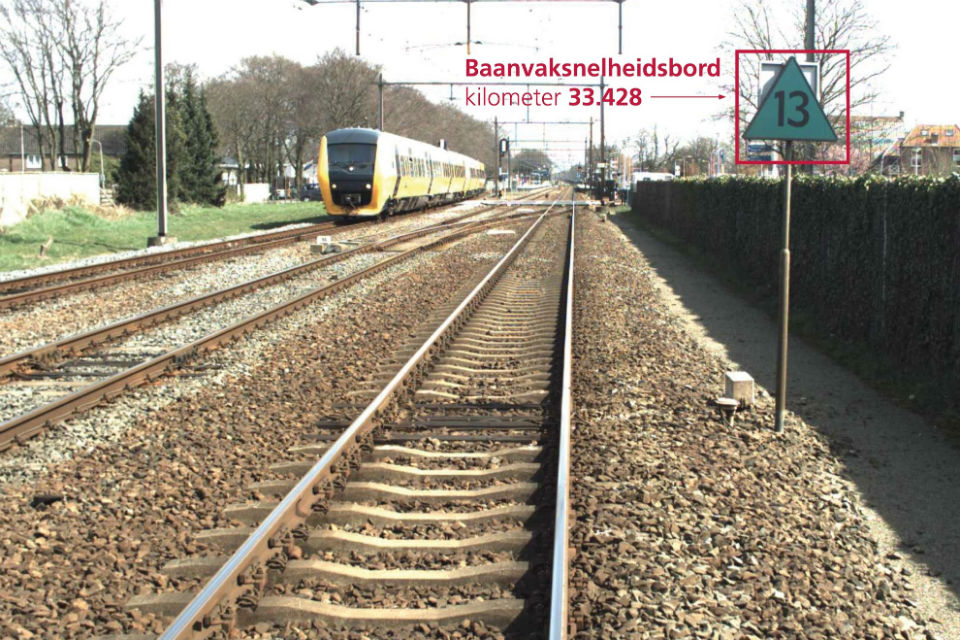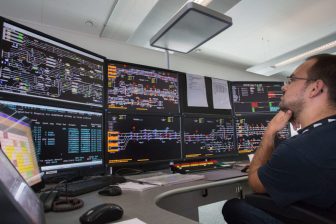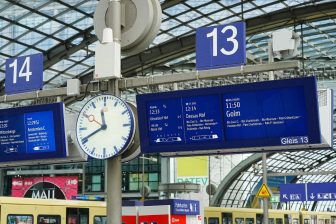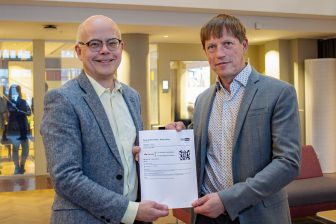
Rail sector works collectively on one information model
Currently, rail sector businesses are still talking in different ways about track switches. Programme Manager Raymond Soeters and CIO Office Manager Arjen Boersma from ProRail believe that it must soon all be in one standard language. They are working together on RailData, the information portal for the rail sector. “We are heading towards a world in which the rail sector works collectively on one information model.”
On 29 March, Raymond Soeters and Arjen Boersma will present their future vision of ‘RailData’ during the RailTech Europe 2017 conference in the Jaarbeurs in Utrecht. They will talk about the latest developments in the RailData information portal, which went live last month. Since then, the most important details about railway objects have been available for ProRail’s partners via www.spoordata.nl. This portal ensures that all parties have equal access to relevant data, so they make decisions based on the same information. Furthermore, according to Soeters and Boersma, they can use this data “to do smart things”.
Maintenance data for the track
This year, ProRail is going to further expand the information in RailData. Soeters: “In the second quarter of 2017 we will make maintenance data for the railway objects available. Then, in the third quarter, the objects’ condition data will be added.” The condition data concerns the state of a sector of track, such as the age of an object and the extent of wear and tear.
According to rail experts, RailData provides “a wealth of information”. Among other things, the data is used in ProRail’s DataLab, a rule-free zone in which experiments are done with big data in order to predict disruptions. Boersma, as CIO Office Manager, is closely involved in this virtual organisation. “In the DataLab we try to combine data about railway objects in such a way that we can make predictions. Currently, part of our research is about disruptions caused by external factors such as people walking on the track, rupture of the track, rupture in overhead lines, switch defects, track subsidence, and defects in insulation rail joints. We are doing this as such factors regularly have a negative effect on train traffic.”
Making predictions
“In a number of cases we make predictions about the behaviour of a switch, for example. By combining historic data of a track switch with other available data, we can predict when a switch will break. This gives us a chance to repair it before it becomes defective, meaning that disruption for passengers is reduced”, says Boersma.
In the DataLab, information is analysed with the help of algorithms. “If the data analysis is good enough, we use it, for example, as part of the RailData programme. This previously also happened with the Digital Viewing (Digitaal Schouwen) project.”
Digital Viewing
With the Digital Viewing application, video images from for example a measuring train can be automatically compared to the track’s design. Data about the signals and signs on the Dutch railway network is recorded on OBE (Overview of Track and Railway Yard) sheets. With digital viewing, camera images are made of the ‘outside’ situation and GPS data is collected. Special software recognises the objects in the images and compares these results with the OBE sheets. Experts can then assess the differences and, depending on the situation, can request that the situation outside, or the drawing itself, is corrected.
ProRail will soon put out a tender for 150 rail projects to be mapped out. “If we are successful in making ‘the outside inside’ for 150 rail projects, a disruption, condition assessment or maintenance activity can always be related to an object. The biggest step forward we have made this year is validating the existing infrastructure on a national level. In addition, we are going to use this instrument to check whether new data coming from an infrastructure project is correct.”
One information model
Looking further into the future, ProRail wants to adopt the BIM (Construction Information Management) method for all infrastructure projects. BIM is a methodology in which all relevant information throughout the whole lifecycle of a construction is shared digitally among all parties in a chain. The aims are better design, fewer construction faults and higher data quality.
An important condition for applying this methodology is that concepts and definitions for all phases of a construction are clearly defined, and supporting ICT systems work with the same information. “There can be a confusion with the language if several words are used to describe one object, such as low signal, dwarf signal or high signal. Professionals are able to understand these different terms, but computer systems cannot handle them”, explains Soeters.
Involve the rail sector
It is therefore important that all partners speak the same language. One of the instruments that makes this possible is the Object Type Library (OTL). A digital check of the data is imbedded into the model. “With this we can avoid a large number of faults. For instance, it is no longer possible that only two rail branches are delivered for a symmetrical switch. The model ensures that there must be three.” Pro-Rail will soon publish the first edition of the OTL.
“In 2017, we are going to pilot the OTL in the first ten infrastructure projects. We will ask engineering companies and rail contractors to feed back information to us in accordance with the OTL. It will take everyone a bit of getting used to, but it is a response to what these parties have asked us for, namely clear definitions. It is important that we properly involve the sector in this, as it requires them to do things too, for instance making adjustments to their ICT systems. Moreover, with their expertise they are in a good position to enrich the OTL and take it to the next level.”
RailData Programme
In 2015, ProRail started the RailData programme to ensure that rail traffic controllers, capacity planners, train drivers, track engineers, repair technicians and inspectors could base their daily work on reliable information about the rail infrastructure.
Soeters: “The programme continually delivers new products, so everyone can see that we are making progress and are keeping the programme vibrant. A nice milestone was the recent launch of the information portal. Instead of waiting until we are ready to link all data together, we made a conscious choice to expand the portal step by step. This means that we are more able to respond to the wishes of our users. There is more data available than ever before. By combining it in a clever way we can avoid an even greater number of defects and thus ensure that passengers enjoy a hassle-free journey.”
On 29 March, Raymond Soeters and Arjen Boersma will give a presentation entitled ’RailData at your fingertips’ during the conference about ‘Digitalisation in the rail sector’ during RailTech Europe 2017. For more information, please visit the conference page.



